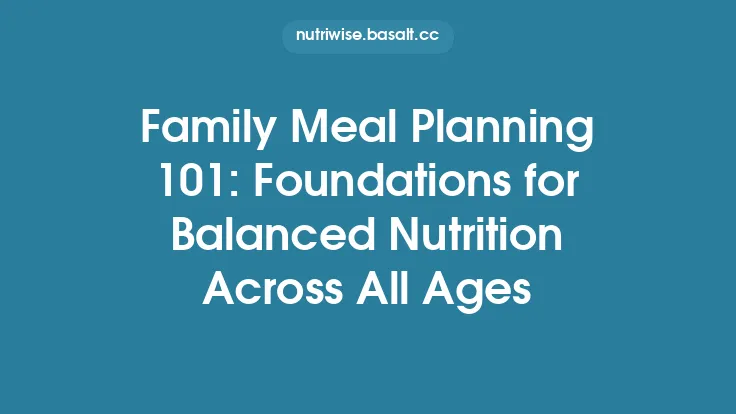Meal planning doesn’t have to be a rigid, “cook‑once‑eat‑once” routine. One of the most powerful ways to stretch a grocery budget while simultaneously cutting food waste is to build your weekly menu around leftovers. By treating leftovers as a core ingredient rather than an afterthought, you can create a flexible, cost‑effective system that feeds the whole family, reduces the environmental footprint of your kitchen, and keeps mealtime interesting.
Why Leftovers Matter in a Budget‑Friendly Kitchen
Financial impact – The average household throws away roughly 30 % of the food it purchases. When you factor in the cost of those discarded items, the waste can amount to hundreds of dollars each year. Repurposing leftovers directly translates into lower grocery bills because you are extracting maximum value from each ingredient you buy.
Environmental benefit – Food that ends up in the landfill generates methane, a greenhouse gas roughly 25 times more potent than CO₂ over a 100‑year horizon. By reducing the volume of waste, you lower your household’s carbon footprint and contribute to a more sustainable food system.
Nutritional continuity – Leftovers often contain a balanced mix of protein, fiber, and micronutrients. When incorporated thoughtfully, they can help you meet daily nutritional goals without the need for additional purchases.
The Core Principles of Leftover‑Centric Meal Planning
- Plan “reverse” meals first – Instead of starting with fresh ingredients, begin each week by listing the leftovers you already have. Identify which components can serve as a base (e.g., roasted vegetables, cooked grains, shredded meat) and build new dishes around them.
- Chunk cooking with “dual‑purpose” recipes – Choose recipes that naturally yield extra portions and lend themselves to transformation. For example, a pot of chili can become a topping for baked potatoes, a filling for tacos, or a base for a hearty soup.
- Standardize storage containers – Uniform, airtight containers simplify inventory checks and make it easier to see what you have at a glance. Label each container with the date cooked and a brief description to avoid “mystery” leftovers.
- Apply the “first‑in, first‑out” rule – Rotate older leftovers to the front of the fridge or freezer, ensuring they are used before newer items. This habit prevents accidental spoilage and waste.
- Embrace flavor‑reset techniques – A change in seasoning, sauce, or cooking method can make the same protein feel entirely new. Think of a roasted chicken breast turned into a Thai‑style chicken salad with lime, cilantro, and peanuts.
Building a Weekly Leftover Blueprint
Step 1: Inventory audit (Sunday or Monday)
- Open the fridge and freezer, pull out all containers, and note the contents on a whiteboard or digital app.
- Categorize items by protein, grain, vegetable, and sauce.
Step 2: Identify “anchor” leftovers
- Choose 2–3 items that can serve as the backbone for multiple meals. Example anchors:
- Cooked quinoa (grain)
- Roasted root vegetables (vegetable)
- Grilled salmon (protein)
Step 3: Map out meals
- For each anchor, sketch three distinct meals. Use a simple matrix:
| Anchor | Meal 1 | Meal 2 | Meal 3 |
|---|---|---|---|
| Quinoa | Quinoa‑black bean bowl with avocado | Quinoa‑fried rice with peas & egg | Quinoa‑stuffed bell peppers |
| Roasted veg | Veggie‑topped pizza | Warm veg salad with feta | Veg‑laden soup |
| Salmon | Salmon Caesar wrap | Salmon & quinoa patties | Salmon chowder |
Step 4: Fill gaps with fresh “complementary” items
- Add a few inexpensive fresh components (e.g., a head of lettuce, a can of beans, a bag of frozen corn) that can be combined with the anchors to complete each dish. Because the bulk of the meal is already prepared, the additional cost is minimal.
Step 5: Schedule cooking and reheating
- Assign specific days for reheating or repurposing each anchor. This prevents “leftover fatigue” and ensures you’re not scrambling for ideas at the end of the week.
Practical Techniques for Transforming Leftovers
| Technique | How It Works | Ideal Candidates |
|---|---|---|
| Sauté & Spice | Quickly reheat in a hot pan with fresh aromatics (garlic, ginger, onions) and a new spice blend. | Cooked meats, roasted veggies |
| Blend & Soup | Combine leftovers with broth, puree, and seasonings for a new soup. | Grains, beans, roasted veg |
| Mash & Form | Mix shredded protein or veggies with binders (egg, cheese, breadcrumbs) and shape into patties or meatballs. | Chicken, turkey, cauliflower |
| Layer & Bake | Assemble leftovers in a casserole dish, top with cheese or sauce, and bake until bubbly. | Pasta, rice, roasted veg |
| Wrap & Roll | Use tortillas, lettuce leaves, or rice paper to encase leftovers with fresh toppings. | Grilled meats, stir‑fry veggies |
| Pickle & Ferment | Quick‑pickle leftover veggies in vinegar, sugar, and salt for a tangy accent. | Carrots, cucumbers, onions |
| Cold‑Plate Remix | Slice cold leftovers thinly and arrange with fresh herbs, nuts, and dressings. | Roast beef, smoked salmon, grilled tofu |
Food‑Safety Fundamentals for Leftover Management
- Cooling window: Move cooked food from the stove to the refrigerator within two hours (or one hour if the ambient temperature exceeds 90 °F/32 °C).
- Storage temperature: Keep the fridge at ≤ 40 °F (4 °C) and the freezer at ≤ 0 °F (‑18 °C).
- Shelf life guidelines:
- Cooked poultry, fish, and ground meats: 3–4 days in the fridge.
- Cooked whole cuts of meat (roast, steak): 4–5 days.
- Cooked grains, beans, and pasta: 5–7 days.
- Roasted or sautéed vegetables: 3–5 days.
- Reheat to safety: Heat leftovers to an internal temperature of 165 °F (74 °C) before serving. Use a food thermometer for accuracy, especially with thick stews or casseroles.
Tracking Savings: Simple Calculations
- Baseline cost – Record the total amount spent on groceries for a typical week (e.g., $120).
- Leftover value – Estimate the cost of each leftover component based on the original purchase price (e.g., a $6 chicken breast yields $4 worth of cooked meat).
- Avoided waste – Subtract the cost of any food that would have been discarded without repurposing.
- Net savings –
\[
\text{Net Savings} = \text{Baseline Cost} - (\text{Grocery Spend} - \text{Leftover Value})
\]
If you spent $115 on groceries but repurposed $30 worth of leftovers, your net savings are $20 for that week. Over a year, that adds up to over $1,000.
Tools and Resources to Streamline Leftover Planning
- Digital inventory apps – Apps like “NoWaste” or “Pantry Check” let you log items, set expiration alerts, and generate recipe suggestions based on what’s inside.
- Labeling kits – Waterproof markers and pre‑cut labels help you quickly note dates and contents.
- Batch‑size calculators – Simple spreadsheet templates can calculate how many servings a cooked batch will provide and how many repurposed meals you can derive from it.
- Recipe databases with “leftover” filters – Websites such as “SuperCook” let you input ingredients you have on hand and return tailored recipes.
Sample 7‑Day Leftover‑Focused Menu
| Day | Main Dish | Primary Leftover Used | Fresh Add‑On |
|---|---|---|---|
| Mon | Quinoa & Black Bean Burrito Bowl | Cooked quinoa (from Sunday roast) | Fresh salsa, avocado |
| Tue | Roasted Veggie & Goat Cheese Flatbread | Roasted carrots & parsnips | Store‑bought flatbread, goat cheese |
| Wed | Chicken‑Thai Salad | Shredded rotisserie chicken | Lime, cilantro, peanuts |
| Thu | Lentil & Veg Soup | Leftover roasted veg | Canned lentils, broth |
| Fri | Salmon & Quinoa Patties | Grilled salmon | Egg, breadcrumbs, dill |
| Sat | Veggie Fried Rice | Day‑old rice | Frozen peas, soy sauce |
| Sun | Beef & Veg Casserole | Leftover beef strips | Tomato sauce, cheese |
Notice how each day reuses a component from a previous meal, requiring only a few fresh items to complete the dish.
Overcoming Common Challenges
- “Same‑taste fatigue” – Rotate seasoning profiles (Mediterranean, Asian, Mexican, Indian) to keep flavors fresh.
- Limited freezer space – Prioritize high‑value leftovers (proteins, grains) for freezing; consume perishable veggies within a few days.
- Time constraints – Use quick‑heat methods (microwave, stovetop sauté) for leftovers; reserve longer reheating (oven bake) for weekends.
- Family acceptance – Involve household members in the repurposing process; let them choose a “leftover makeover” each week to increase buy‑in.
The Bigger Picture: From Household to Community
When a family consistently reduces food waste, the cumulative effect can ripple outward. Surplus leftovers that are still safe but not needed can be shared with neighbors, donated to local food banks (following safety guidelines), or composted to enrich soil. By treating leftovers as a valuable resource, you contribute to a culture of mindful consumption that benefits both your wallet and the planet.
By integrating leftovers as a foundational element of your weekly meal plan, you unlock a powerful strategy for cutting costs, minimizing waste, and keeping meals diverse and satisfying. Start with a simple inventory, apply the transformation techniques, and watch both your grocery bill and your environmental impact shrink—one repurposed plate at a time.





